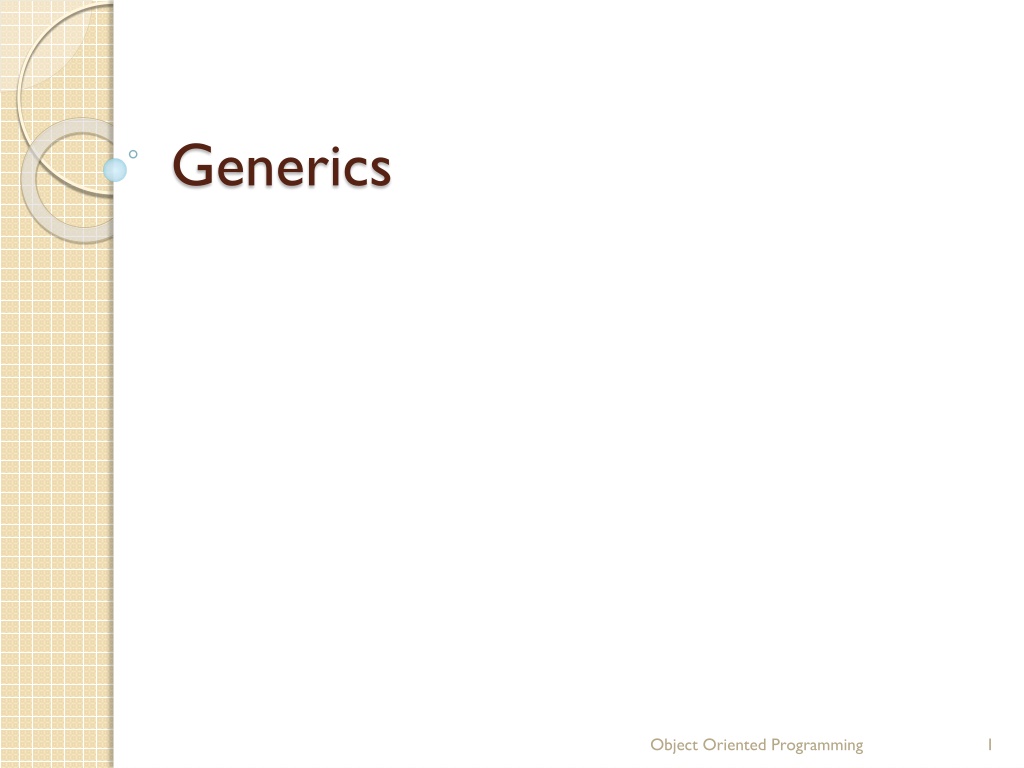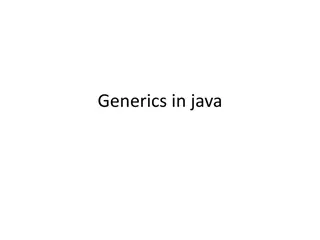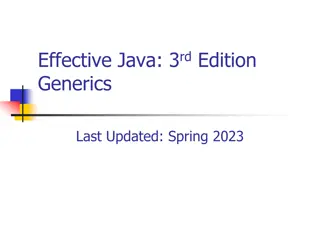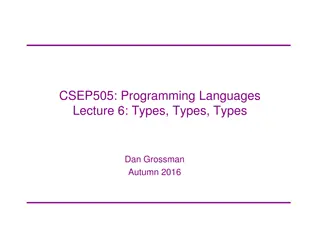Generics
Generics in Java allow for compile-time error detection by enabling the definition of classes, interfaces, or methods with generic types. This feature replaces generic types with concrete types, such as with the ArrayList class in Java. Discover motivations, benefits, defining generic classes, methods, bounded generic types, raw types for backward compatibility, and wildcard generic types.
Download Presentation

Please find below an Image/Link to download the presentation.
The content on the website is provided AS IS for your information and personal use only. It may not be sold, licensed, or shared on other websites without obtaining consent from the author.If you encounter any issues during the download, it is possible that the publisher has removed the file from their server.
You are allowed to download the files provided on this website for personal or commercial use, subject to the condition that they are used lawfully. All files are the property of their respective owners.
The content on the website is provided AS IS for your information and personal use only. It may not be sold, licensed, or shared on other websites without obtaining consent from the author.
E N D
Presentation Transcript
Generics Object Oriented Programming 1
What is it? Generics enable you to detect errors at compile time rather than at runtime. With this capability, you can define a class, interfance or a method with generic types that the compiler can replace with concrete types. For example, Java defines a generic ArrayList class for storing the elements of a generic type. The key benefit of generics is to enable errors to be detected at compile time rather than at runtime. If you attempt to use an incompatible object, the compiler will detect that error. Object Oriented Programming 2
Motivations and Benefits The motivation for using Java generics is to detect errors at compile time. Here, <T> represents a formal generic type, which can be replaced later with an actual concrete type. Replacing a generic type is called a generic instantiation. By convention, a single capital letter such as E or T is used to denote a formal generic type. Object Oriented Programming 3
Defining Generic class A generic type can be defined for a class or interface. A concrete type must be specified when using the class to create an object or using the class or interface to declare a reference variable. DemoGenericStack.java Object Oriented Programming 4
Generic methods A generic type can be defined for a static method. GenericMethodDemo.java Object Oriented Programming 5
Bounded Generic type A generic type can be specified as a subtype of another type. Such a generic type is called bounded. There may be times when you want to restrict the types that can be used as type arguments in a parameterized type. For example, a method that operates on numbers might only want to accept instances of Number or its subclasses. BoundedTypeDemo.java Object Oriented Programming 6
Raw types and backward compatibility A generic class or interface used without specifying a concrete type, called a raw type, enables backward compatibility with earlier versions of Java. GenericStack stack = new GenericStack(); // raw type This is roughly equivalent to GenericStack<Object> stack = new GenericStack<Object>(); Object Oriented Programming 7
Wildcard generic type You can use unbounded wildcards, bounded wildcards, or lower-bound wildcards to specify a range for a generic type. What are wildcard generic types and why are they needed? WildCardNeedDemo.java bounded wildcard It has a compile error in line 8 because intStack is not an instance of GenericStack<Number>. Thus, you cannot invoke max(intStack). The fact is that Integer is a subtype of Number, but GenericStack<Integer> is not a subtype of GenericStack<Number>. Object Oriented Programming 8
Unbounded wildcard ? (<? extends Object) <?> is a wildcard that represents any object type. It is equivalent to <? extends Object>. What happens if you replace GenericStack<?> with GenericStack<Object>? It would be wrong to invoke print(intStack), because intStack is not an instance of GenericStack<Object>. Note that GenericStack<Integer> is not a subtype of GenericStack<Object>, though Integer is a subtype of Object. AnyWildCardDemo.java even Object Oriented Programming 9
Lower bounded wildcard The third form, ? super T, called a lower- bound wildcard, denotes T or a supertype of T. SuperWildCardDemo.java Object Oriented Programming 10
Program Implement the following generic method for linear search. public static <E extends Comparable<E>> int linearSearch(E[] list, E key) LinearSearch.java Object Oriented Programming 11
Generic class with two type parameter You can declare more than one type parameter in a generic type. To specify two or more type parameters, simply use a comma-separated list. TwoGen.java Object Oriented Programming 12
Cont. Generic Types differ based on their type arguments. - Gen<T> class Gen<Integer> g1 = new Gen<Integer>(); Gen<String> g2 = new Gen<String>(); g1 = g2 //error Constructor can be generic even if its class is not. Object Oriented Programming 13
Generic Interface In addition to generic classes and methods, you can also have generic interfaces. Generic interfaces are specified just like generic classes. MinMax.java Object Oriented Programming 14
Generic class hierarchy Generic classes can be part of a class hierarchy in just the same way as a non-generic class. Thus, a generic class can act as a superclass or be a subclass. The key difference between generic and non- generic hierarchies is that in a generic hierarchy, any type arguments needed by a generic superclass must be passed up the hierarchy by all subclasses. This is similar to the way that constructor arguments must be passed up a hierarchy. GenHierarchy.java Object Oriented Programming 15
Method overriding in generic class A method in a generic class can be overridden just like any other method. Gen2MethodOver.java Object Oriented Programming 16
Some generic restrictions Type Instantiated. Restrictions on Static Members Generic Array Restrictions A generic class Throwable. This means that you cannot create generic exception classes. Parameters Can t Be cannot extend Object Oriented Programming 17
List, Stack, Queue and Priority Queue Object Oriented Programming 18
Collection Framework Choosing the best data structures and algorithms for a particular task is one of the keys to developing high-performance software. In object-oriented thinking, a data structure, also known as a container or container object, is an object that stores other objects, referred to as data or elements. ArrayList class, which is a data structure to store elements in a list. Java provides several more data structures that can be used to organize and manipulate data efficiently. These are commonly known as Java Collections Framework. Object Oriented Programming 19
Cont. The common features of these collections are defined in the interfaces, and implementations are provided in concrete classes. Object Oriented Programming 20
Cont. The Java Collections Framework supports two types of containers: One for storing a collection of elements is simply called a collection. The other, for storing key/value pairs, is called a map. In this unit, our attention is on to the following collections: Sets store a group of nonduplicate elements. Lists store an ordered collection of elements. Stacks store objects that are processed in a last-in, first-out fashion. Queues store objects that are processed in a first-in, first- out fashion. PriorityQueues store objects that are processed in the order of their priorities. Object Oriented Programming 22
Iterator Each collection is Iterable. You can obtain its Iterator object to traverse all the elements in the collection. The Collection interface extends the Iterable interface. The Iterable interface defines the iterator method, which returns an iterator. The Iterator interface provides a uniform way for traversing elements in various types of collections. TestIterator.java Object Oriented Programming 23
Lists The Collection interface and defines a collection for storing elements in a sequential order. To create a list, use one of its two concrete classes: LinkedList TestArrayAndLinkedList.java List interface extends the ArrayList or Object Oriented Programming 24
Linkedlist Vs ArrayList The critical difference between them pertains to internal implementation, which affects their performance. ArrayList is efficient for retrieving elements and LinkedList is efficient for inserting and removing elements at the beginning of the list. Both have the same performance for inserting and removing elements in the middle or at the end of the list. Object Oriented Programming 25
Comparator Interface Comparator can be used to compare the objects of a class that doesn t implement Comparable. You can define a comparator to compare the elements of different classes. To do so, define a class that implements the java.util.Comparator<T> interface and overrides its compare method. TestComparator.java Object Oriented Programming 26
Static methods of Lists and Collections Object Oriented Programming 27
Vector and Stack Class Vector is a subclass of AbstractList, and Stack is a subclass of Vector in the Java API. Vector is the same as ArrayList, except that it contains synchronized methods for accessing and modifying the vector. Synchronized methods can prevent data corruption when a vector is accessed and modified by two or more threads concurrently Object Oriented Programming 28
Queues and Priority Queues A queue is a first-in, first-out data structure. Elements are appended to the end of the queue and are removed from the beginning of the queue. In a priority queue, elements are assigned priorities. When accessing elements, the element with the highest priority is removed first. Object Oriented Programming 31























